|
Sixty years after the atomic bombing. Through the unflagging efforts of residents and assistance from around Japan and the world, the city of Hiroshima, reduced to a burnt plain by a single atomic bomb, has achieved amazing recovery and growth.
During those 60 years the people overcame much and created much, including A-bomb literature and a peace movement.
Suffering physically and emotionally, the hibakusha (A-bomb survivors) wept with every new appearance of bones in the rubble. They joined sit-ins to protest nuclear tests; they told the world their horrific stories in hopes of preventing another use of nuclear weapons.
At each stage, their actions have been guided by an intense desire for peace.
The Peace Memorial Museum opened 50 years ago in 1955. Constructed ten years after the atomic bombing on the ravaged earth near ground zero, the building has grown with the people over these 50 years, playing a vital role in their peace activities.
Thus, this special exhibition is in two parts: Fifty Years for the Peace Memorial Museum in Exhibition Room (3) and Sixty Years for Hiroshima in Exhibition Room (4).
|
1945-1954 Collecting Rubble on the Burnt Plain-Before the Museum
|
1On August 14, 1945, Japan decided to accept the terms of the Potsdam Declaration. The following day, the emperor spoke on the radio announcing to the Japanese people that Japan had surrendered. The long war was over.
Slowly, people drifted back to the scorched plain that had swallowed so many lives. Shacks appeared, schools reopened. In response to extreme shortages, a black market grew up in front of the station.
While most of the population was struggling to survive, one man walked the burnt plain picking up stones and roof tiles, an isactivity that laid the groundwork for the Peace Memorial Museum.
In 1949, an A-bomb Reference Material Display Room, predecessor to the current museum and later named the Atomic Bomb Memorial Hall, opened in the Chuo Community Hall in Moto-machi.
Also that year, a design for a Peace Memorial Park was selected through a design competition, and the Hiroshima Peace Memorial City Construction Law went into force. These events led in 1951 to construction of Memorial Museum of Atomic Bombed Relics (now, Peace Memorial Museum).
The structure and exhibits of the future Peace Memorial Museum were taking shape.
|
 |
 |
 |
 |
 |
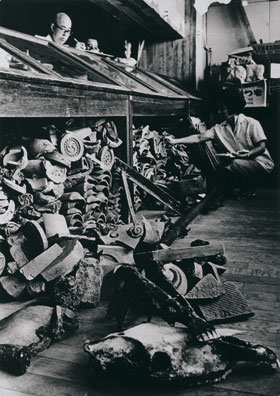
1*Collecting rubble on the scorched plain
Courtesy of Seiichi Nagaoka
During that heartbreaking time, one man was going around the city collecting A-bombed roof tiles and stones. Shogo Nagaoka, later to become the first director of the Peace Memorial Museum, was a part-time instructor for the Geological and Mining Science Department of Hiroshima University of Literature and Science. He walked through the ruins daily, a pack on his back, to unearth objects that would reveal the effects of the atomic bomb. Nagaoka suffered high fever and diarrhea from radiation poisoning. In the photo, Nagaoka is on the far left.
3*Pamphlets edited by Shogo Nagaoka
Right HIROSHIMA/Written by Shogo Nagaoka
Published by the A-bomb Materials Collection Support Association 1954
Left Hiroshima-From that Day/Written by Shogo Nagaoka
Published by the A-bomb Materials Collection Support Association 1955 Donated by Seiichi Nagaoka
Shogo Nagaoka avidly collected A-bomb artifacts and studied the damage based on data he gradually amassed. The pamphlet contains photos collected by Nagaoka and the results of his research up to that point. He measured the shadows the heat ray etched on rocks and other objects, then used that data to determine the point of detonation.
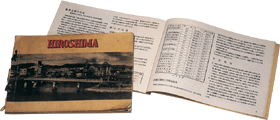
|
 |
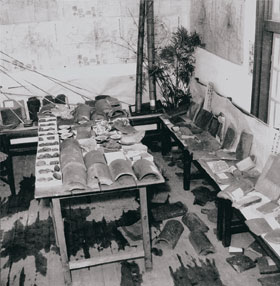
2*Opening a small display room
September 1949 Hiroshima City Chuo Community Hall
Courtesy of Chugoku Shimbun
In September 1949, Hiroshima City opened the A-bomb Reference Material Display Room in the Chuo Community Hall in Moto-machi to display the artifacts Shogo Nagaoka had collected. The shabby displays consisted of A-bombed roof tiles and stones placed on pieces of paper on desks and chairs. They were the fruit of his walks through the burnt plain at a time when virtually no one else could summon the time and energy to think about A-bomb artifacts.
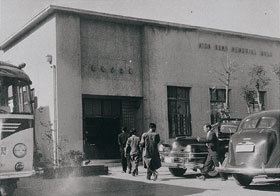
4*Atomic Bomb Memorial Hall
Moto-machi
Courtesy of Seiichi Nagaoka
The Atomic Bomb Memorial Hall opened just north of the Chuo Community Hall in 1950. Next to A-bombed roof tiles and stones were handmade maps, panels, and a square panoramic model of Hiroshima City immediately after the bombing. Humble as it was, the facility appeared as a tourist site on the Hiroshima City Almanac. Tourist buses made it one of their stops, as did overseas dignitaries.
|
|
| |
 |
 |
 |
 |
 |
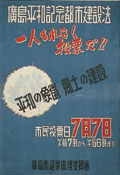 |
|
5*Construction of the peace memorial city
With city coffers empty, reconstruction efforts stalled. Desperation prompted a movement to press the national government to enact a special law to assist the city. In May 1949, the persistent activists persuaded the National Diet to pass the Hiroshima Peace Memorial City Construction Law, which was approved by 90% of the public in a referendum that July. The national government began funding construction of Peace Memorial Park and its facilities.
|
|
6*Design competition for Peace Memorial Park
Collection of Shigeru Sera Courtesy of Hiroshima Municipal Archives
In search of the best possible design for Peace Memorial Park and its facilities, the city held a design competition in 1949. The design ultimately selected from 145 candidates was created by the group of Kenzo Tange, assistant professor at the University of Tokyo at the time. This brilliant plan integrated the park into the city by basing it on a 100 meter-wide road running east and west through the city, then aligning it with the A-bomb Dome at its heart.
|
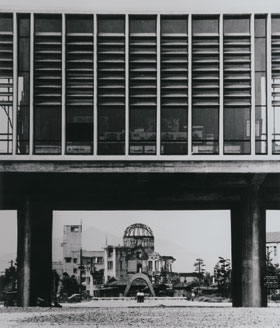
7*A-bomb Dome as focal point
July 19, 1956 Peace Memorial Park
Courtesy of Chugoku Shimbun
The park design placed the A-bomb Dome straight ahead for visitors entering the park from the Hundred-meter Road (now, Peace Boulevard). The centrally located Memorial Museum of Atomic Bomb Relics (now, Peace Memorial Museum), the facility built to display A-bomb materials, was raised up on massive pillars to serve as a magnificent entrance gate and avoid obstructing the view of the A-bomb Dome. The concept was entirely novel. The photo shows the initial Peace Memorial Museum. The center of the museum, the Cenotaph for the A-bomb Victims (official name: Memorial Monument for Hiroshima, City of Peace) and the A-bomb Dome lie on a straight line.
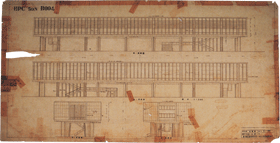

9*Blueprints of the Memorial Museum
Courtesy of Tange Associates
Blueprints for the present Peace Memorial Museum drawn in 1950 by K. Tange and Associates of the Planning Research Group, Architectural Department, Tokyo University. By raising the central Memorial Museum of Atomic Bombed Relics onto pillars, Tange sought to express the powerful human will to rise from the ruins with gentle support from the buildings on each side. One senses strength in the thick pillars supporting the building.
|
 |
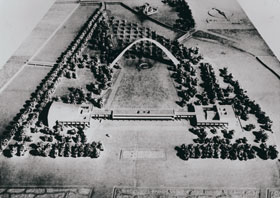

8*Rising from the ruins
1951 Peace Memorial Park
Photo by Kenzo Tange Courtesy of Tange Associates
Construction of the Memorial Museum of Atomic Bombed Relics began on February 1951. Before the park took shape, shacks filled the area and graveyards spread across the grounds of ruined temples. As new buildings went up over spots where people had died, bones of A-bomb victims continued to be unearthed. The photo looks east from the Myohoji Temple graveyard (now, the site of the International Conference Center Hiroshima).
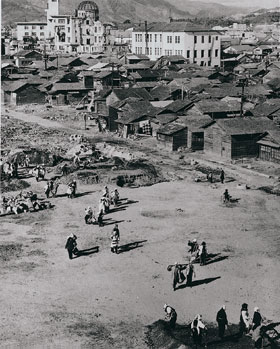
10*Leveling the ground in Peace Memorial Park
1952 Looking at Peace Memorial Park from the museum under construction
Photo by Yuichiro Sasaki Courtesy of Kiyomi Sasaki
Construction of the Memorial Museum of Atomic Bombed Relics began on February 1951. Before the park took shape, shacks filled the area and graveyards spread across the grounds of ruined temples. As new buildings went up over spots where people had died, bones of A-bomb victims continued to be unearthed. The photo looks east from the Myohoji Temple graveyard (now, the site of the International Conference Center Hiroshima).
|
|











